1989-1999:
THE MOST TUMULTUOUS DECADE
By Jim Stiles
I'd like to be able to say that I anticipated the staggering changes that were about to turn Moab, Utah upside down when I started the Zephyr in 1989. I'd like to say I was a prophet but I can't. I didn't really see it coming.
After the defeat of the toxic waste incinerator, it looked as if Moab might become a sort of peaceful oasis in the red rock country. We had some tourists, about 400,000 a year at Arches, up about 90,000 from a decade before, but not enough to seriously disrupt the town. We had a few river running outfits that made a comfortable living for its owners and great summer work for a lot more. There were plenty of rental opportunities for all those part time summer employees---at one point in the late 1980s, almost one in every five homes was empty. The played out uranium boom was over once and for all.
But we should have seen it coming. With the birth of mountain biking and its almost explosive popularity in Moab, lycra-clad yupsters from Colorado and California and Beyond began to show up in ever increasing numbers. And they came to do more than challenge their own skills on the Slickrock Bike Trail. They came to buy.
It was a standard line at many real estate offices in the late 80s: "Tell us," the Aspenites would grin, "How many houses can we steal today?" Quite a few was the answer. Sometimes visitors to Moab arrived empty-handed and left town a day later, the owner of four Moab homes, and still had change from their $100,000.
That's how it began. But Old Moab was still hanging on and in the first few years, in the early 90s, some of Moab's biggest 'controversies' focused on old issues and old ideas.
What follows are a few flashbacks; from Day One and Ground Zero, this is how Moab got from there to here...
1989: BIRTH OF THE ZEPHYR & THE BOOK CLIFFS HIGHWAY
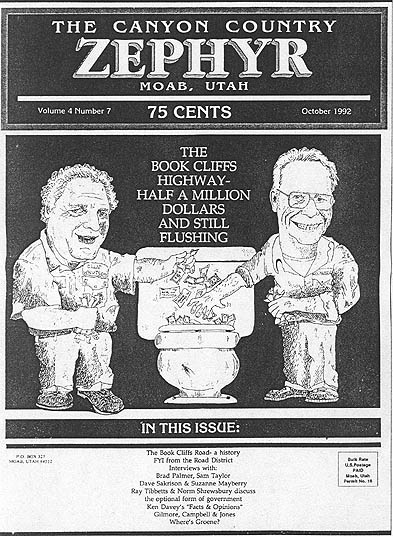 At
about the same time the Zephyr was taking shape, so was the Grand County Special
Services Road District. Lame duck commissioners Jimmie Walker and Dutch Zimmerman,
recently defeated in the 'Toxic Incinerator Overthrow' and incumbent David Knutson
created this autonomous governing body, appointed Dutch and David's father to
be board members and hired Jimmie to be the paid administrator. With mineral
lease money funded to the counties by the federal government, the new road board
had a grandiose plan: Build a paved highway from I-70 over the rugged Book Cliffs
to Vernal. The road board received a $6 million loan from the Community Impact
Board and hired the engineering firm of Creamer & Noble to start the engineering
work.
At
about the same time the Zephyr was taking shape, so was the Grand County Special
Services Road District. Lame duck commissioners Jimmie Walker and Dutch Zimmerman,
recently defeated in the 'Toxic Incinerator Overthrow' and incumbent David Knutson
created this autonomous governing body, appointed Dutch and David's father to
be board members and hired Jimmie to be the paid administrator. With mineral
lease money funded to the counties by the federal government, the new road board
had a grandiose plan: Build a paved highway from I-70 over the rugged Book Cliffs
to Vernal. The road board received a $6 million loan from the Community Impact
Board and hired the engineering firm of Creamer & Noble to start the engineering
work.
From the beginning Creamer & Noble's role in the project had raised eyebrows. Creamer & Noble had lobbied the legislature to release mineral lease monies to the counties; now they were lined up to receive a lion's share of it. In September 1989, Commissioner David Knutson spoke freely with the Zephyr about the road board's relationship with the engineering firm...
"Basically we told him that if he could find the money for Grand County to do this project, he could do the engineering on it. It was more of a gentleman's agreement."
But later the engineering contract was put out for bid. According to Knutson, the bidding process was a farce...
"It was pretty much of a given who's going to get it. And it was. There wasn't any intention of even seriously considering anybody else. Steve Creamer was the one who got the money, who pushed it through. He had all the contacts. That was a gentleman's agreement in the first place. For all intents and purposes, the decision to go with Steve Creamer had been made a long time ago. Right or wrong, it had."
The next day, Knutson's comments in the Zephyr appeared on KTVX News in Salt Lake City. A bewildered Steve Creamer was interviewed on camera and shakily denied any wrong-doing. It was the first crack in the Book Cliffs Highway scheme.
1989: THE FIRST 'LEGITIMATE' BABY OF THE YEAR AWARD
As The Zephyr approached the end of year #1, a Moab citizen pointed out some fine print to me one day. This was the result in the Page two editorial of the Jan/ Feb 1990 issue...
Leonardo da Vinci was a great artist and inventor. Sarah Bernhardt was a great actress. Alexander Hamilton was the first U.S. Secretary of the Treasury. What does this diverse group of people have in common? Their parents were not married when they were born. To use the antiquated vernacular, they were 'illegitimate.'
If they were born in Moab, and if their birthdays fell close to the first of the year, all of them would be disqualified from the First Baby of the Year Contest, sponsored by almost two dozen merchants. Each year these sponsors award a variety of presents to the baby and the parents of the newborn. But the contest rules are explicit. The fine print reads: 'Winning baby must be legitimate.'
The Zephyr urged the organizers of the contest to re-evaluate their position; after all, why punish the baby? And we proposed that if the contest rules were not changed, a group of Zephyr advertisers were prepared to award the prizes anyway, if the first baby born in 1990 was to an unwed mother. The contest organizers did re-evaluate and the "illegitimate" disqualifier was removed.
Score one for Leonardo.
1990: THE NEXT BONEHEAD IDEA: THE KOKOPELLI THEATER
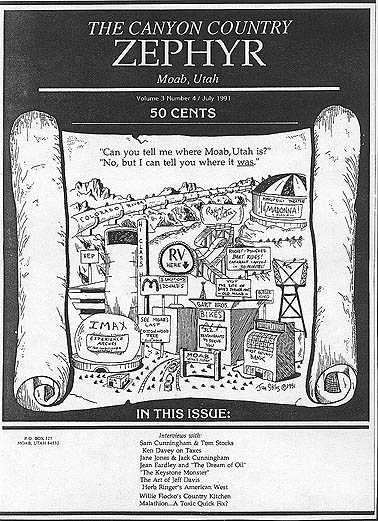 This
is the state that gave us cold fusion. But in the summer of 1990, we caught
wind of a project that rivaled it. From the August 1990 issue...
This
is the state that gave us cold fusion. But in the summer of 1990, we caught
wind of a project that rivaled it. From the August 1990 issue...
Recently the University of Utah, in conjunction with the BLM, announced plans to construct a $9.5 million theater complex on the Sand Flats Road adjacent to the Slick Rock Bike Trail. The multi-phase project includes an outdoor amphitheater, an outdoor theater in the round, a theater of the stars for astronomical programs, and an enclosed year-round performing arts center. The price tag would be paid for by $6 million in federal building funding and the remainder from non-government matching funds.
For a while it looked as if this project might proceed. Senator Garn introduced legislation calling for $6 million in appropriations to build what some were calling 'Wolftrap West.' Stories of even more grandiose plans began to leak out, including a massive roll-back roof for the theater. Scoping meetings were called for August.
But somewhere along the way the University lost interest in the project and in Moab. Plans by the U to establish a campus for the arts in Moab also dissipated like August clouds over the mountains. By 1992 the Kokopelli Theater was just another goofy idea that had come and gone like a 24 hour bug.
1990: THE COUNTY ATTORNEY IS DEFEATED BY HERSELF
In 1986, Elaine Matthews Coates was elected to serve as Grand County Attorney, upsetting the longtime incumbent Bill Benge. Four years later, she was up for re-election and it appeared that she would run unopposed. But a newly amended law threw a wrench into that scenario. From the June 1990 issue...
The newly amended law allows citizens to vote 'yes' or 'no' to a county attorney candidate running for election...if the county has three or fewer active or licensed attorneys residing within the county.
At the time, Grand County had four attorneys but one of them had been suspended by the Utah Bar for six months. I almost made a nuisance out of myself calling the Utah Attorney General Office trying to get a ruling on the applicability of the law to our county. Finally the AG's office determined that Grand County indeed only had three attorneys at the time of the filing deadline. County clerk Fran Townsend determined that Elaine Coates would have to run as a yes/no candidate. In November Elaine Matthews Coates was soundly defeated by herself.
1991: A PEOPLE'S PARK? OR MILL CREEK CONDOS?
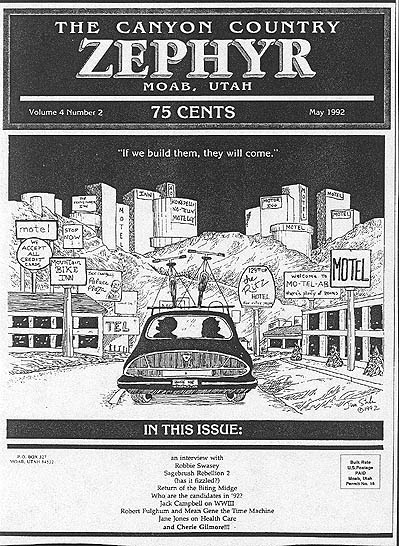 From
the June 1991 issue...
From
the June 1991 issue...
The Moab City Council has an opportunity to do something visionary. Moab has always been blessed with a lot of green space. We've taken for granted the fact that within the city limits and right around its perimeter, we have orchards and alfalfa fields and pastures---sights that we've grown accustomed to. But all that is likely to change as more and more out-of-town speculators buy up relatively cheap acreage.
One such piece of property is a six acre parcel on 400 East, across from Mill Creek Drive. The owner has recently proposed to lease this property to the city with an option to buy after 10 years...It is one of the loveliest spots in Moab.
But if a developer gets hold of it, I doubt if it will be for the purpose of turning it into a wildlife sanctuary. Condos loom just over the horizon.
It would cost each Moab citizen about $2.75 a year for a decade to preserve and protect this valuable 'green space.' That's nothing...This could truly be a People's Park---a piece of yesterday that we've set aside. Talk to your councilperson; there's still time,but one of these days that land will be sold and then it will be too late to do anything except kiss it goodbye."
The city council did nothing. Four years later we "kissed it goodbye." Today it really is called Mill Creek Pueblos.
1992: THE ZEPHYR JOINS THE 20TH CENTURY
After three years of scribbling on yellow legal pads for transcription by weary typists, The Zephyr finally embraced the technological age. I purchased a computer, thanks in great part to a donation by the best-selling author Robert Fulghum and his wife Dr. Lynn Edwards. Fulghum also joined "the staff" as Roving Reporter for a couple of years, covering (or uncovering) everything from streakers on graduation day to backcountry toilet etiquette. Thanks guys.
1992: THE CITIZENS REVOLT!
In 1990 David Knutson and Manuel Torres won landslide elections as Grand County Commissioners. With their election, The Zephyr observed what it thought was a growing arrogance by its elected leaders. Some citizens began to talk about referendums and revolts. Here's how it played in March 1992 after Knutson informed me he and Torres would no longer participate in Zephyr interviews...
...Didn't he think the interviews were a public service, I asked? To the contrary Dave replied that they were a detriment to the citizens. He believed that the 1990 election gave them a mandate to run the county as they saw fit. Annoying 'media' like the Zephyr merely confused the voters and made their jobs tougher. So I asked, did he think we should just pack up and go home, let them 'do their job' and check back in 1994?
Always the candid commissioner, David grinned and said, 'Something like that.'
What can be done? A possible solution lies within the Utah State Constitution. The law provides specific ways of re-structuring local government to make it more responsive to the citizens it serves. And the citizens have the opportunity to decide which re-structuring options suit their needs best. It is the best example I have seen of government BY the people.
Incredibly, Moab and Grand County citizens did it again. For the second time in four years, a petition drive was created. Enough names were obtained to put the issue to a vote: Did Grand County want to scrap its current three-person county commission in favor of a seven-person county council? After a long and hard-fought campaign, the referendum won with 56% of the vote. The next February a special election was held to fill the seven new county council spaces. It felt like the dawning of a new day. It proved later to be our high water mark.
1992: MOAB MOTEL MANIA
In the winter of 1991-92, seven new motels were built, almost overnight it seemed. Old landmarks like the Canyonlands Cafe vanished in a day. It was a watershed moment for Moab...we've been tearing down and bulldozing under ever since.
1993: THE NEW COUNCIL IS ELECTED
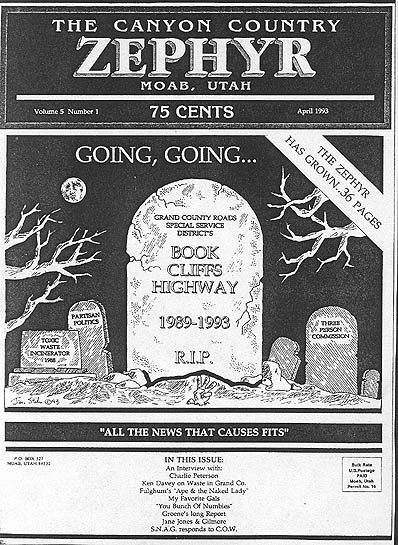 From
the March 1993 issue...
From
the March 1993 issue...
A year ago I ran an agitated diatribe about the latest shenanigans of the Grand County Commission...which ultimately led to mutiny by the general public.
What followed is the stuff of political legend. From the proverbial straw came the Citizens for Better Government, a proposal to change our government, a spirited debate and then a vote by the people.
A frazzled County Clerk Fran Townsend proceeded to put the mechanics in motion to fulfill the mandate set by the people. We endured the primary, culled the number of candidates from 24 to 14. And finally, on February 9, we completed our long journey with the election of the first Grand County Council.
The new councilmen are: Peter Haney, John Hartley, Charlie Peterson, Ken Ballantyne, Paul Menard, Bill Hedden and John Maynard.
With their election came the death of the Book Cliffs Highway. The road had a lot of public support in 1989 when it was first proposed. But four years later, public opinion had shifted as Grand County citizens wondered if there weren't better ways to spend the mineral lease monies. The road board insisted that the funds could only be used for roads and warned that the revenues would be lost completely if the new council tampered with it.
The council tampered with it anyway. The project was killed and the mineral lease funds diverted to other areas of need in Grand County.
Before its "death" the Special Services Road District spent almost $500,000 on the Book Cliffs Road. Creamer & Noble were paid handsomely for its engineering work on a road that would never be built.
1993: EASTER MADNESS...MADNESS!
From the May 1993 issue...
I had been doing so well. After last spring's overwhelming tourist onslaught, I was determined to improve my attitude. It was time to put an end to all those dismal apocalyptic editorials about the end of civilization as we know it. After all, I convinced myself, this madness only lasts six to eight weeks. I could survive that.
And then I was run over...flattened...in mid-Bliss by Easter Weekend. I have never seen anything like it in my life. It surpassed anything anyone in this town has ever seen. In spite of my pledge to the contrary, do you know what we all witnessed?
Yes, that's exactly right. It really WAS the end of civilization as we know it.
Did I once complain about Don Holyoak's cows?
1993: CHICKEN LITTLE WAS RIGHT ("Incoming!!!")
From the June 1993 issue...
The United States Army wants to launch missiles from Green River and drop their boosters over Canyonlands near Hatch Point, scenic helicopter flights have started operation on both ends of town, the state office is about to lease the old airport to a company that will provide...guess what...more scenic flights.
You just can't have too many scenic flights over the canyon country.
Yes you can. Where did I put my Stinger Missile Launcher?"
Eventually, the Army backed off, helicopters were restricted and the old airport is still just sitting out there crumbling. Proof that good things could still happen in Mob, Utah in 1993.
1993: THE RECALL ELECTION
From the December 1993 issue...
All six council members who faced recall were retained, with an average 60/40 margin of victory...It must now make hard decisions on the future of the hospital, planning and zoning, possible consolidation of some city and county services, the threat of ever-increasing property taxes, and a community that seems to be growing and changing at a speed that hasn't been seen since the uranium days.
And that broader concern, uncontrolled and unlimited growth, is the council's greatest challenge. Can the council...WILL it be able to help maintain the small-town values that make Moab such a special place? Is it willing to take action to keep north and south Highway 191 from turning into another 'Strip' of fast-food chains and modular motels? Is it willing to protect home-grown businesses from invading Wal-Marts? Does the council have the vision or even the right to shape Grand County's future in such a way?"
1993: TRAM RIDE TO GLORY?
From the November 1993 issue.
You say exploding tourism, nine new motels, a McDonald's, JB's and a water slide have left you in a state of shock? You haven't seen anything yet.
The Portal Recreation Area, Inc. plans to build a 2200 foot aerial tram to the top of the sandstone cliffs just south of the Colorado River that will forever alter that spectacular view, and it doesn't appear there is a thing anyone can do to stop it.
According to the business document, 'initial plans call for the 2,200 foot low profile quad chairlift, a paved parking lot, giftshop and snackbar facilities, amphitheater and stage, trails, shaded look-out points, and night time illumination of the majestic red rock rims.'
Hey! I know...let's move the water slide from the east side of town to the west, right along side the chairlift. You can take the tram up, grab a bite at the snack bar, take in the view of the Atlas tailings pond from the gazebo, and ride a wave down. More and more, we're looking like a town for the 21st century, aren't we?
1994: MOAB SWINGS LIKE A PENDULUM DO...
From the December 1994 issue...
I used to believe in the cyclical nature of things. I'm not sure I feel that way anymore. Change almost seems like an erratic kneejerk reaction to whatever happens to be alienating citizens on any given election day. Look at Grand County...
Every two years, for the last five general elections, we have 'thrown the bastards out.' There is no ideological curve to it. In fact, this community looks more like a bunch of schizophrenics than anything else...
And I am not sure that it really matters. While a more 'reform-minded' governing body has been in office these last two years, it has still been, for the most part, 'business as usual' in Grand County. A recently passed subdivision ordinance will make development a little more costly and a little more organized.
Anything one governing body chooses to do can be undone by the next. We give new meaning to the word 'gridlock.'
1995: I CAN'T REMEMBER A THING
1996: A BIG CHANGE...A BIG GAMBLE
From the January 1996 issue...
This is the 76th issue of the Zephyr. Since I took Volume 1 Number 1 to the printer on March 14, 1989, this newspaper has experienced a number of changes and evolutions...Now it is about to change dramatically.
This is the last monthly edition of the Canyon Country Zephyr. Exactly seven years after its first press day, this newspaper will be published bi-monthly and distributed FREE in the Moab area, with additional distribution in Salt Lake City and several southern Utah communities.
...So that's it. I'm crossing my fingers that this works. But regardless of what happens in the future, thanks for your kind and generous support.
1996: SHOULD WE DRAIN LAKE POWELL?
From the April/May 1996 issue...
There were always those who hated the dam. Ken Sleight, Phil Hyde, Eliot Porter, Katie Lee, Kent Frost, Buz Hatch, Al Quist, Ed Abbey. There were others, many others of course, who floated the river before the dam was even a project to be seriously considered (and feared). And more who joined the ranks after construction began, including David Brower, who was devastated.
In the thirty four years that have passed since Lake Powell began to rise behind the dam, thousands of people, tens of thousands, who never even saw Glen Canyon have added their voices and their anger to the once lonely chorus of dam haters.
...It may well be that someday, a decade from now, or five decades from now, that intelligent minds will come together and agree that Glen Canyon Dam no longer serves a useful purpose (as if it ever did). That it has become a liability more than an asset. The decision to drain the lake may well be made for "economic reasons."
And they may be right. But for me, the economics has nothing to do with it. It's what was lost, what lies beneath the water... all that beauty. That's what motivates me.
It's time to restore a masterpiece.
1997: THE NEW GRAND STAIRCASE/ESCALANTE NATIONAL MONUMENT
From the December 1996/January 1997 issue...
A state geologist predicts that coal reserves inside the new national monument "could supply our needs for the next 400 years." Now think about that a minute. The coal would keep us supplied until the year 2396 AD.
Does anyone with half a brain think that this planet is going to still be depending on a coal as a basic energy resource in 400 years?
Let's look at that concept in reverse. Imagine someone in the 16th Century proclaiming that he had enough leaches for bloodletting until well past the year 2000.
Do you see what I mean?
1998: THE DEATH OF JOHN DINSMORE
From the June/July 1998 issue...
Our entire community was up in arms over the price of garbage collection last year. Tempers boiled over at packed public meetings. But the use of deadly force by the police against a suicidal man in a confrontation that lasted all of five minutes and ended with the flash of a 12 gauge shotgun generated a mild flurry of objections and by Christmas, the matter passed into history.
...Dinsmore was shot to death by the shotgun because the officer who fired somehow felt that five police officers with handguns against one drunk man with a kitchen knife was not an adequate response. John at least deserved some more time.
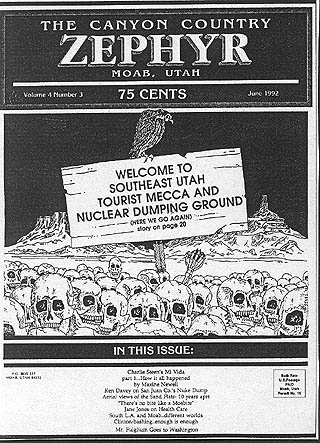
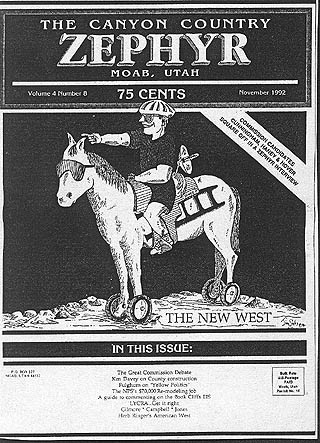 To Zephyr Main Page April-May 1999
To Zephyr Main Page April-May 1999
 At
about the same time the Zephyr was taking shape, so was the Grand County Special
Services Road District. Lame duck commissioners Jimmie Walker and Dutch Zimmerman,
recently defeated in the 'Toxic Incinerator Overthrow' and incumbent David Knutson
created this autonomous governing body, appointed Dutch and David's father to
be board members and hired Jimmie to be the paid administrator. With mineral
lease money funded to the counties by the federal government, the new road board
had a grandiose plan: Build a paved highway from I-70 over the rugged Book Cliffs
to Vernal. The road board received a $6 million loan from the Community Impact
Board and hired the engineering firm of Creamer & Noble to start the engineering
work.
At
about the same time the Zephyr was taking shape, so was the Grand County Special
Services Road District. Lame duck commissioners Jimmie Walker and Dutch Zimmerman,
recently defeated in the 'Toxic Incinerator Overthrow' and incumbent David Knutson
created this autonomous governing body, appointed Dutch and David's father to
be board members and hired Jimmie to be the paid administrator. With mineral
lease money funded to the counties by the federal government, the new road board
had a grandiose plan: Build a paved highway from I-70 over the rugged Book Cliffs
to Vernal. The road board received a $6 million loan from the Community Impact
Board and hired the engineering firm of Creamer & Noble to start the engineering
work.
 This
is the state that gave us cold fusion. But in the summer of 1990, we caught
wind of a project that rivaled it. From the August 1990 issue...
This
is the state that gave us cold fusion. But in the summer of 1990, we caught
wind of a project that rivaled it. From the August 1990 issue...
 From
the June 1991 issue...
From
the June 1991 issue...
 From
the March 1993 issue...
From
the March 1993 issue...

